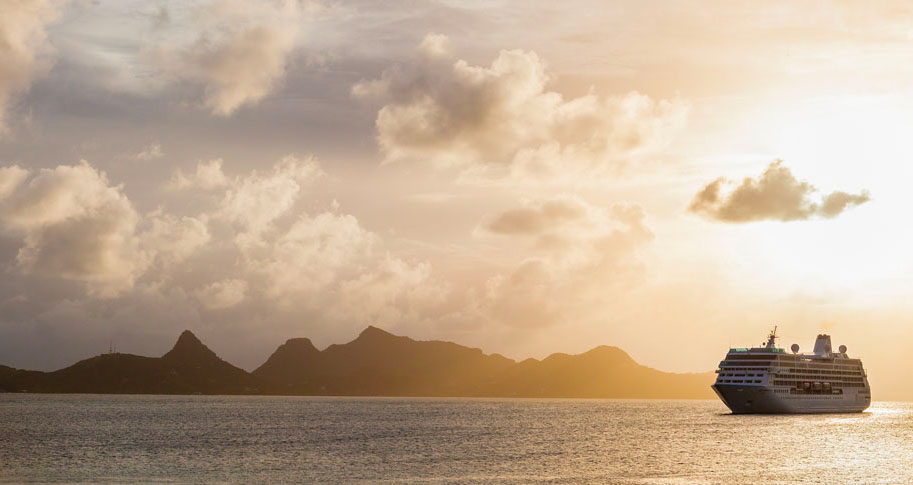“Naut” In the Same Boat: Price Elasticity in the Cruise Industry

February 26, 2021 | By Ryan Decker
Researchers: Dinesh K. Gauri
After being cooped up inside for months, many people may be looking to schedule a much-needed vacation once the pandemic is under control. The problem? We don’t know when it will be safe to travel again. The CDC and State Department still advise against non-essential travel to many countries, including most of Europe, Canada, and Mexico. Many countries still prohibit American tourists from entering even if they wanted to.
Travel restrictions and safety concerns have caused major problems for the travel and entertainment industries. Cruise companies have suffered tremendously due to months-long no-sail orders and bad publicity in 2020. Although the CDC recently lifted no-sail orders, cruises cannot sail with passengers until ships can ensure proper health and safety measures.
Customers who can’t wait to board a cruise again may decide to buy their tickets far in advance. As a result, cruise companies use purchase timing for price discrimination – modifying prices or issuing discounts based on how far in advance the purchase is made – to collect additional revenue and make informed decisions.
In other industries, consumers are more sensitive to prices early in the sales window. This sensitivity decreases as the advance sales window shortens. For example, say you need to book a flight for your best friend’s wedding. If you book the flight early and see an expensive flight, you may wait to get a better deal or look for other options. If you book the flight only a few days before departure, you will probably pay far more because you need to be at the wedding no matter what. Your price elasticity of demand, or how reactive you are to price changes, decreases over time.
Mingyu Joo, Dinesh Gauri, and Kenneth Wilbur conducted a study to see if this holds true in the cruise industry. In their paper, “Temporal Distance and Price Responsiveness: Empirical Investigation of the Cruise Industry,” they study the relationship between price and demand during the advance sales period and provide the first evidence that demand can become more responsive to price approaching the date of consumption.
When Do Consumers Book Their Cruises?
“When consumers buy in advance, the time between purchase and consumption is called temporal distance,” the authors write. “For example, some consumers buy vacation tickets three months in advance, whereas others buy the same tickets just three weeks in advance.” From their study of 400,000 bookings in the Florida cruise market, the authors found that bookings increased throughout the sales period until the last few weeks before departure.
The data shows that very few consumers book their cruises early in the sales period. Tickets were offered for purchase up to a year in advance, but 87% of tickets were sold in the last 20 weeks. Ticket sales peaked a month before departure before sharply declining. In addition, the authors found that “consumers who buy early are more likely to buy higher priced cruises, whereas late buyers tend to book cheaper cruises.” This is consistent with previous findings in the cruise industry, as more expensive cabins usually sell out first.
Early Bird Discounts
For industries that offer advance sales, such as airlines or hotels, demand is generally more responsive to price early in the sales period and becomes less responsive as time goes on. Because of this, “a common pricing practice is to charge low prices when demand is more price sensitive for capacity utilization, and to charge high prices when demand is less price sensitive to enhance unit margins,” the authors write. This strategy is easily understood when considering the airfare example given earlier. Tickets are generally cheaper in advance to lock in as many seats as they can, or in other words, improve capacity utilization. When only a few seats are left, the airline can raise prices and capture additional revenue from last-minute passengers who will buy the ticket regardless of the price. These last-minute purchases help improve unit margins.
This traditional pattern of price responsiveness to demand promotes “early bird discounts,” where prices start low and rise as time goes on. This pattern appears across all studied advance sales industries in previous research. To understand if this pattern exists in the cruise industry, the authors develop several models to investigate how the price responsiveness of demand changes during the advance sales period.
Swimming Against the Tide
The authors provide the “first evidence of a negative causal relationship between price responsiveness and temporal distance in any advance sales industry.” Prior research had focused upon a limited set of industries. In short, they show that as the departure date approaches, consumers become more responsive, or elastic, to price – a pattern not seen in other industries. Why is this result unique to the cruise industry? The authors consider possible reasons why – sellouts of expensive itineraries, competitor prices, and strategic purchase delays – but find no evidence that any of these possibilities contribute to the outcome.
Since consumers buy more expensive itineraries and cabins earlier in the sales period, could the consumers become more sensitive to price due to sellouts of expensive cruises? The authors find that no, cruises rarely sell out before the final two weeks before departure, so sellouts are unlikely to cause this negative relationship.
What if the prices of other cruises from competitors cause consumers to be more sensitive to price changes late in the sales period? If competing cruise prices become more similar late in the booking period, demand may become more sensitive to price due to higher competition. “Another possibility is that competitive prices may be falling with temporal distance, whereas the focal firm’s prices rise with temporal distance.” The data does not support either possibility, however, so competitors’ pricing patterns do not explain the relationship between temporal distance and price elasticity. Competing cruise companies either followed similar pricing patterns throughout the booking window or showed no pattern at all.
Strategic shoppers try to time their purchases to get the best deal. In some industries, waiting to buy until very late in the sales period results in better prices. For example, shoppers may be able to score great deals on concert tickets or rental cars if they wait until the last minute. Cruise prices and airfares, however, do not typically follow this pattern. Even if a cruise or flight has substantial capacity remaining, they very rarely severely discount their prices. Part of the reason for this practice is to capture last-minute consumers willing to pay any price for a spot, thus improving the cruise lines’ margins.
But there’s a bigger reason: “[companies] said that they did not want to train their consumers to expect last-minute deals…. Committed consumers arrive early and buy early. Less committed cruisers arrive late and pay more (if they purchase at all).” While strategic purchase delays are unlikely to explain why price sensitivity increases as the departure date approaches, cruisers would benefit from buying their tickets early in the sales window to get the best deal.
Optimal Pricing Strategy
The authors find compelling evidence to suggest that demand can become more responsive to price as the consumption date approaches. From this conclusion, it may seem logical for cruise companies to lower prices as time goes on rather than increase them. “However, this absolute increase in price responsiveness does not necessarily imply that the optimal price path declines with temporal distance,” they write. “Consumers’ baseline demand for cruises increases as temporal distance falls, more than offsetting the fall in demand due to higher prices and increased price responsiveness.” Lowering prices right before departure would hurt the company’s margins by leading consumers to expect last-minute discounts and delay their purchases. This explains why cruise companies steadily increased prices by a total of 20% in the final 25 booking weeks.
The company’s pricing policy and the resulting consumer response drive the observed relationship between price responsiveness and temporal distance. The findings might differ under a different pricing strategy. Previous research on the cruise industry highlights one of these strategies: third-degree price discrimination. Offering specialized prices to consumers from different customer groups has been shown to improve revenue and promote understanding of the target market.
In their study of price discrimination in the cruise industry, Aidin Namin, Dinesh Gauri, and Robert Kwortnik recommended implementing small discounts early in the sales period. If cruise companies implemented this strategy, how would this affect price responsiveness over time? What’s more, will these discounts be enough to convince uneasy cruise-goers to book a cruise despite the unknown future of the pandemic?
After a shutdown of more than a year, cruise bookings are strong for the second half of 2021, showing that cruisers are ready to get back to sea. Due to vaccine success and strict public health protocols, fifty percent of cruisers say they will likely cruise in 2021, while 73% say they will in the next few years. This pent-up demand is good news for the cruise industry. According to the authors’ research, demand for cruises should increase as the sail date approaches, allowing companies to adjust prices to improve profit margins. These may be uncharted waters for cruise companies, but there’s a unique opportunity to understand how consumers behave in dynamic pricing games when companies get back to business.


